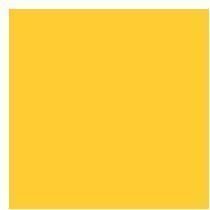Using the Color Yellow in Desktop Publishing Projects
Using Yellow in Desktop Publishing Projects
Yellow is the brightest of the primary colors, and indeed all colors. From cheerful daffodil and citrus versions to more creamy hues, color variations in the yellow family offer an undoubtedly sunny persona to many DTP projects. Because of its bright intensity, yellow can be tiresome when used in abundance. So, desktop publishers should take care with the shade and amount of solid yellow used in designs. Although many yellows alone are not good for text, a yellow background paired with black offers one of the most noticeable and readable color combinations. It is also an excellent choice for caution-themed layouts because of its association in nature with the markings of predators.
What other unspoken messages does yellow communicate when you use it in your desktop publishing projects? Let’s find out. Based on the following feelings and color theory associations prevalent in response to colors in the yellow family, you can determine if yellow is a good option for your next DTP project.
Color Associations
The color yellow is equated with the brightness and heat of the sun in virtually every culture. The eye registers bright yellow before any other color. However, yellow’s reflectivity also makes it very fatiguing to the eye. Over time, a bright yellow background tires the eye and has a negative response. Like red, yellow stimulates the appetite and increases metabolism, so it is a preferred color in the food service and tableware industries. Because of it’s positive association with food as well as its readability as a background, yellow is a good option for both signage and packaging. It almost universally connotes sunshine, light and warmth. Because of the association with light and the sun, it also often signifies imagination and enlightenment. Bright yellow is widely seen as a very positive and intellectual color.
Lighter, pastel yellows are considered mellow, soft and cheerful. Daffodil yellow maintains enough brightness to be cheerful, but also offers a more energetic and eye-catching tone, and can connote a youthful exuberance. Creamy yellow variations tend to give a more sophisticated feel and are often associated with rich, delicious foods like favorite desserts. Lemon yellow is naturally associated with citrus, cleanliness and freshness. Greener yellows that approach chartreuse can be off-putting in Western culture, although almost every shade of yellow is appealing to Asians.
Terms like “yellow-bellied” and “yellow journalism” offer a clue to some of the negative cultural associations related to the color yellow. It is often used to describe cowardice and can sometimes reference unscrupulous or disdainful practices. In addition, some yellow tones are associated with illness, and the color does not promote a healthy look against many skin types.
Yellow in its many variations can’t help but infuse desktop publishing designs with a decidedly positive feel. Because it does not have a strong gender association like variations of red and blue, yellow can give layouts a more universal appeal. The sunshine and warmth inherent in the color yellow can bring a fresh and light tone to projects. It can tame the heat in a red/orange analogous scheme and serve to lighten the mood. Including yellow can give cooler colors like green and blue a bit of pizzaz and can also offer an environmental appeal.
This post is part of the series: Using Primary Colors in DTP Projects
The primary colors encompass a full range of emotions from energetic to sedate. What do the red, yellow and blue communicate when used in desktop publishing projects? This 3-part article series highlights each primary color and describes its cultural associations and DTP design considerations.
